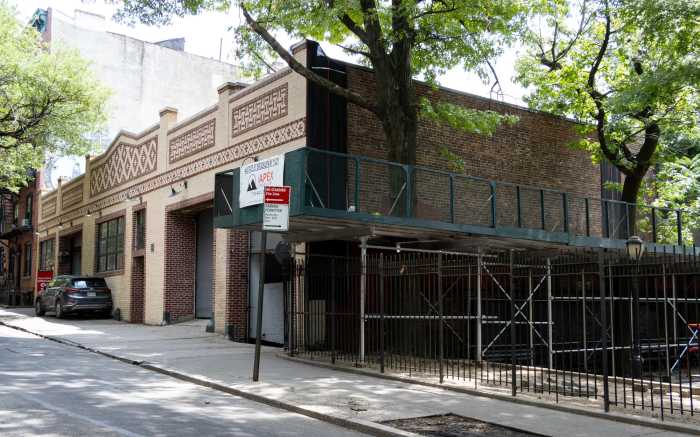Borough President Markowitz, one of Bruce Ratner’s staunchest allies, dropped a bombshell on Tuesday, saying that the $1-billion basketball arena at the heart of Atlantic Yards is no longer “economically feasible” and that Ratner and state officials need to give the expensive design “a second look” so that the structure can actually get built.
Markowitz’s bombshell statement was first issued on Tuesday to the New York Times, which has a business partnership with Ratner and has not been critical of the developer’s stalled 16-skyscraper arena, office and residential complex. It was later released to other media outlets.
In the statement, Markowitz refers to a recent statement from Ratner that the developer was looking for ways to cut costs in Frank Gehry’s innovative design — a design that was once a main selling point of the controversial project.
“As we all know, the economic realities have changed since the inception of this project,” Markowitz said. “As has been widely reported, Forest City Ratner is looking hard at ways to realize cost savings by doing things like using more cost-effective materials.
“To that end, I am asking Forest City Ratner and the Empire State Development Corporation to give [the arena] design a second look, and conceptualize a sports and entertainment venue that is more economically feasible, but provides the modern amenities our residents and visitors to Brooklyn demand and deserve,” he said.
In a subsequent statement issued to The Brooklyn Paper, Markowitz said he remained confident that the “arena will be a beautiful, world-class facility,” but that “efficiencies and cost savings need to be found.”
On the topic of Gehry, the Beep went cold-blooded.
“Frank Gehry is a world-class architect,” Markowitz said, but then deferred to Ratner to decide what to do with the starchitect, whose expensive design was one of the main selling points of Atlantic Yards. “It’s the decision of the developers and others to decide who is the right person for the job.”
That’s a far cry from what Markowitz told The Brooklyn Paper in May, when he praised new Gehry renderings that depicted the future home for the New Jersey Nets with the swirling, curling metallic panels that make his Walt Disney Concert Hall in Los Angeles and Guggenheim Museum in Bilbao, Spain. Markowitz said the design was “setting a new standard for excellence.”
“It’s been exciting to watch the Atlantic Yards project and Gehry’s designs evolve,” Markowitz said at the time. “With each new concept, we’ve seen creative possibilities for a thriving, gleaming city center like no other.”
So much for “thriving.” Ratner actually spent most of last year driving down expectations, first telling the New York Times in March that the $4-billion project no longer had a timetable and that the “Miss Brooklyn” office tower at the intersection of Flatbush and Atlantic avenues could not be built because Ratner had failed to line up an anchor tenant during the real-estate boom that was just beginning to go bust.
In August, Ratner delayed his own timetable for the publicly financed arena, admitting that there was no way the Nets could be happily ensconced in the so-called “Barclays Center” until the 2011-12 season.
Then, just before Christmas came reports that Gehry had laid off his entire Atlantic Yards design team.
It’s unclear if the arena — and, indeed, Atlantic Yards itself can be saved at this point. The credit crunch has put pressure on all developers, and the state has a massive shortage of subsidies for affordable housing, grants on which Ratner is depending.
Meanwhile, come February, a $152-million loan that Ratner took out to buy property in the Atlantic Yards footprint — a loan that has now accrued to $177 million — comes due. The Wall Street Journal reported that Ratner is in talks with his creditors to extend the loan, but such credit is tight right now.
Atlantic Yards opponents, who have long called for Atlantic Yards to be scaled back so that it could be built without massive public subsidies, looked at Markowitz’s statement with befuddlement.
“Now Marty says that the project is not economically feasible,” said Daniel Goldstein, a spokesman for Develop Don’t Destroy Brooklyn. “But we have been saying all along that it wasn’t feasible in a good economy, either. That’s why the whole thing needs to be scrapped so we can develop the rail yard.”
He also accused Markowitz of providing political cover for Ratner as he downgrades the Gehry-designed arena from an international icon of architecture that helped Atlantic Yards win a speedy approval from state officials into something more pedestrian.
“Ratner says he needs to build something cheaper, so now Markowitz says we need something cheaper,” Goldstein said. “Have you ever seen such a sloppy and silly attempt at political cover?”
Or, as the Web site Gowanus Lounge put it bluntly last week, “Gehry’s $1-billion work of art to be turned into $400-million crap box.”
It is unclear what comes next. Ratner has said he wants to trim costs, and now Markowitz has once again echoed his favorite developer and longtime donor to his Best of Brooklyn charity.
“We look forward to discussing the borough president’s proposal with him and continuing to work with him and others to bring this project to fruition,” said Ratner spokesman Joe DePlasco.
There are any number of ways that state officials can heed Markowitz’s request to step in. But those same officials can go beyond the Beep’s call for a design tweak and kill the project outright in a number of ways.
For instance, Ratner has not lined up the housing subsidies he needs. Also, the state has condemned, but not actually seized, several key properties in the Atlantic Yards footprint that Ratner needs.
Though unlikely, the ESDC could also demand a new review of the project, given that the Atlantic Yards that got approved at the end of 2007 is a different project with a more-expensive arena at the core.
The state agency could also stop fighting several existing lawsuits against the project, and reach a settlement.
Hours after an earlier version of this story was posted on BrooklynPaper.com, the public condemned Markowitz for his “dishonesty.”
“These cost-saving measures sound a bit frightening,” posted Michael from Bay Ridge. “Firstly, altering the design will only make it worse. … Secondly, can they really change the plans at this point? If a particular structure was approved, that structure should be built. If they would like to change it, then there must be a new approval of the changes.
“Personally, I am shocked by the dishonesty and disregard for the public displayed in the project,” he added. “It sounds more like something from Soviet Russia, than from 21st-century Brooklyn.”

























